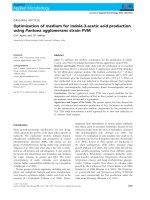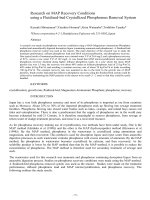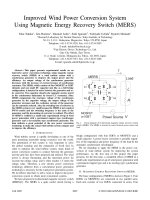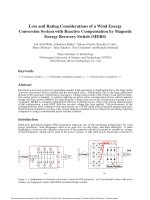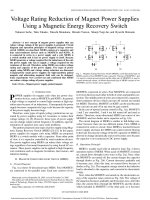Reactive Power Compensation Using Capacitor
Bạn đang xem bản rút gọn của tài liệu. Xem và tải ngay bản đầy đủ của tài liệu tại đây (496.08 KB, 30 trang )
CONTENTS
Introduction
Literature Survey
Problem Identification
Objective Of The Project
Project Analysis And Design
Project Implementation
Conclusion
Future Work Suggested
Reference
INTRODUCTION
• Power Factor correction (PFC) is applied to
electric circuits as a means of minimizing the
inductive component of the current and thereby
reducing the losses in the supply.
• Power factor (PF) is the name given to the ratio
of the active or usable power measured in
kilowatts (KW), to the total power (active and
reactive) measured in kilovolt amperes (KVA).ie:
Power Factor = KW / KVA.
POWER TRIANGLE
Electrical power in an AC circuit has three components: real
power (P), reactive power (Q) and apparent power (S).
Real power is considered to be the work producing power
measured in watts (W), or kilowatts (kW). Real power produces
the mechanical output of a motor.
Reactive power is not used to do work but is needed to operate
equipment and is measured in volt‐amperes‐reactive (VAR) or
kilovar (kVAR)
Apparent power (also known as demand power) is comprised of
(vectorial sum) both real and reactive power and is measured in
units of volt‐amps (VA) or kilovolt‐amps (kVA).
DISADVANTAGES
OF
LOW POWER FACTOR
Increases heating losses in the
transformers and distribution equipment.
Reduce plant life.
Upgrade costly equipment.
Decrease energy efficiency.
Increase electricity costs by paying
penalties.
Power factor correction capacitors; Essentials & CautionsM.H.Shwehdi, M.R.Sultan
Dept. of Electr. Eng., King Fahd Univ. of Pet. & Miner., Dhahran
Date of Current Version : 06 August 2002
Page(s): 1317 - 1322 vol. 3
Optimal selection of capacitors-IEEE:
S.Sudehararajan & A Pahwa
Dept. of Electr. & Comput. Eng., Kansas State Univ., Manhattan, KS
Date of Current Version : 06 August 2002
Page(s): 1499 - 1507
Optimal Reactive Power Planning and Compensation Effects
on Transmission Loss Components
K. Barot; H. Bhattacharya,
Power & Energy Syst. Group, Univ. of Waterloo.
Date of Current Version : 23 July 2007
Page(s): 1 - 7
Universal input single-phase single-stage power supply with
power factor correction and automatic voltage clamping
Chongming Qiao; Smedley, K.M.
Dept. of Electr. & Comput. Eng., California Univ., Irvine, CA
Date of Current Version : 07 August 2002
Page(s): 907 - 913 vol.2
High-capacity hybrid power filter for harmonic suppression and
reactive compensation in the power substation
Lina Wang An Luo
Dept. of Electr. Eng., Tsinghua Univ., Beijing
Date of Current Version : 10 January 2005
Page(s): 215 - 220 Vol.1
LPF is a main problem that our industries face in today’s
world. There are many factors that leads to LPF.
The aim of our project is reactive power compensation
using automatic capacitor banks.
We using automatic capacitor PFC, because fixed
capacitor has following disadvantages……
•
•
•
•
•
Manual operation(on/off)
Not meet the require kVAr under varying loads.
Can result leading power factor
Cause over voltage
Penalty by electricity authority
Types of PFC
The choice of the correct power factor correction
equipment depends on the type of loads present and
by their way of working
• Individual compensation is most effective if the majority of the
reactive power is concentrated on few loads with high power
and that work for long period of time.
• Central compensation is best suited for systems where the
load fluctuates through out the day. If the absorption of reactive
power is variable, it is advisable the use of automatic regulation
than fixed capacitors.
INDIVIDUAL COMPENSATION
CENTRAL COMPENSATION
PROJECT ANALYSIS &
DESIGN
AREA OF FOCUS
As a part of our project, we did a case study on Cochin Port Trust and
found that the power factor was below 0.9. as per our calculation, at 0.85
pf, the total cost including penalty was Rs. 3,51,394.25 per month. It’s
noticed that the total cost got reduced to Rs. 3,32,653.25 per month,
after the installation of the capacitor bank that increased the PF to 0.94.
The cost of capacitor was found to be Rs.200/kVAR and the cost of
capacitor installation could be replaced in a period of 1 year and 2
months.
SITES
PUMP HOUSE 1
PUMP HOUSE 2
RAIN WATER
PURIFING
AD BLOCK
FIRE HOUSE
TELEPHONE
EXCHANGE
BELT DRIVE
SUPPLY
NORTH END
CT CANTEEN
12th CROSS
ROAD
RNAS
CLUB
HOSPITAL
CISF
MOTORS
MOTOR 1
MOTOR 2
MOTOR 1
MOTOR 2
RATIN
G
52 HP
52 HP
37 Kw
37 Kw
PUMP
5 HP
3
INDUCTION
MOTOR
INDUCTION
MOTOR
PUMP
60 HP
3.7
Kw
60 HP
6
MOTOR
MOTOR 1
MOTOR 2
MOTOR
MOTOR
MOTOR
MOTOR
MOTOR
MOTOR
MOTOR
MOTOR
MOTOR
MOTOR
MOTOR
MOTOR
1
2
1
2
3
1
2
WORKING
PERIOD(hrs)
TRUE
POWER(kW)
3
3
3
3
TOTAL kWh
76.5 229.5
74 222
3.8 11.4
6
10
47.83 287
44.13
20 HP
7.5 HP
7.5 HP
5 HP
12 Kw
12 Kw
24
14.71
6
6
12
16
11
3.68
12
12
12
12
12
12
12
12
12
12
12
16
12
12
14
24
24
24
24
24
Kw
Kw
Kw
Kw
Kw
Kw
Kw
Kw
Kw
441.3
353
66.2
22.1
144
192
12 192
24 288
12 168
36 864
24 576
•
•
•
•
•
Total load demand
=405.65kW
Total kWh
=4056.50kWh
Total kW in 1 month
=12169.50kW/month
Total kWh in 1 month
=121695.00kWh/month
Total amount in 1 month =Rs 334661.25/month
TARIFF
PF RANGE
INCENTIVE OR PENALITY
PF b/w 0.9 to1 .15%energy charge for each 0.01
unit increases in pf from 0.9
less than 0.9
1% energy charges for every 0.01
fall in pf from 0.9
Cost of energy per unit=2.75Rs/kWh/month
•At 0.85pf
Penalty
= 5%*334661.25
=Rs 16733.00
Total cost including penalty
=Rs(334661.25+16733.00)/month
=Rs 351394.25/month
•At 0.94pf
Incentive
= 0.6%*334661.25
= Rs 2008.00/month
Total cost
= Rs(334661.25-2008.00)/month
=Rs332653.25/month
pf
Selection of capacitor for 0.85
PFold = 0.85
PFnew= 0.94
M =0.367
kVARcap
=165.81kVAR
Cost of capacitor= Rs 200 per kVAR
Total cost of capacitor, kVARcap
=165.81 kVAR * Rs 200
= Rs 33,162.
Incentive
= Rs 2008.00/month.
The capacitor installation cost will be compensated in
33162/2008
=16.51 months
=1 year & 2 months.
Here our hardware is of passive…….
Because
Passive components are those that do not
require electrical power to operate.
Guaranteed stability
Passive filters scale better to large signals
(tens of amperes, hundreds of volts), where
active devices are often impractical
No power consumption.
Inexpensive (unless large coils are required)
